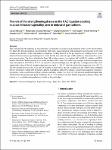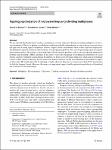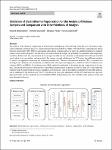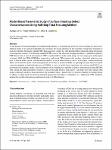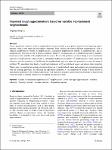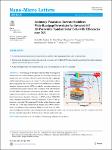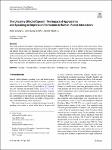Search
Author
- Amir, Ebrahimi (2)
- Aydin, Azizi (2)
- George, Haller (2)
- James, M. Fiore (2)
- next >
Subject
- robotics (9)
- Engineering (8)
- engineering (8)
- công nghệ (3)
- next >
Date issued
- 2020 - 2023 (215)
- 2010 - 2019 (28)
- 2001 - 2009 (6)
Has File(s)
- true (249)
Search Results
This work presents the influence of microstructural constituents on liquation crack formation in the cast Ni-based superalloy, René 108. The investigation was divided into three parts: characterisation of the material's microstructure in pre-weld condition, hot ductility studies and analysis of liquation cracking induced by the gas tungsten arc welding process. Using advanced electron microscopy techniques it is shown that the base material in pre-weld condition is characterised by a complex microstructure. The phases identified in René 108 include γ matrix, γ' precipitates, MC and M23C6 carbides, and M5B3 borides. Based on Gleeble testing, it was found that René 108 is characterised by high strength at elevated temperatures with a maximum of 1107 MPa at 975 °C. As a result of const... |
We use material-distribution-based topology optimization to design a three-port frequency dividing multiplexer at microwave frequencies. That is, by placing a good electric conductor inside the design domain, we aim to design a passive device that splits the incoming signal’s frequencies into two frequency bands and transmits them to their respective output ports. The Helmholtz equation models the time-harmonic wave propagation problem. We solve the governing equation using the finite element method. The adjoint variable method provides the required gradients, and we solve the topology optimization problem using Svanberg’s MMA algorithm. In this study, we present a technique for modeling the distribution of a good electric conductor within the design domain. |
Additive manufacturing technologies have several well-known advantages; however, the surface quality of the printed parts is poor, compromising the corrosion and mechanical properties. Thus, surface finishing treatments are necessary. The most post-processing treatments proposed in the literature are mechanical or chemical. The formers are contact techniques and cannot be suitable for complex geometry, while the latter use strong and dangerous reagents. This paper is aimed to investigate the effect of the electropolishing treatment, a contactless technique, using an eco-friendly electrolytic solution in reducing the roughness and improving the fatigue properties of Ti6Al4V specimens produced by electron beam melting technology. Several parameters affecting the effectiveness of the e... |
The analysis of the chemical composition of biomass plays an important role in all steps of the life cycle of biomass, especially in thermal conversion processes. Electrothermal vaporization (ETV) coupled with inductively coupled plasma optical emission spectrometry (ICP-OES) is a promising approach for biomass analysis as almost no sample preparation is required, samples can be analysed quickly, and the release of elements from the sample can potentially be quantified with temperature resolution. In this work, the concentration of seven important side and trace elements is determined in beechwood, torrefied wood, wheat straw, miscanthus, and spruce bark. For comparison and validation of the ETV setup, four additional methods of analysis are applied to determine the elemental concen... |
As the demand of structural integrity in manufacturing industries is increasing, the ultrasonic array technique has drawn more attention thanks to its inspection flexibility and versatility. By taking advantage of the possibility of individual triggering of each array element, full matrix capture (FMC) data acquisition strategy has been developed that contains the entire information of an inspection scenario. Total focusing method (TFM) as one of the ultrasonic imaging algorithms, is preferably applied to FMC dataset since it uses all information in FMC to synthetically focus the sound energy at every image pixel in the region of interest. Half-skip TFM (HSTFM) is proposed in multi-mode TFM imaging that involves a backwall reflection wave path, so that the defect profile could be re... |
Image processing algorithms are essential for clarifying the image and improving the ability to recognize distinct characteristics of the image. The field of digital image processing is widespread in several research and technology applications. In many of these applications, the existence of impulsive noise in the obtained images is one of the most frequent problems. The median filter is a strong method to remove the impulsive noise; it effectively eliminates salt and pepper noise from the image. The main target of this paper is to investigate efficient median filter units to be connected to a general-purpose processor (GPP) for FPGA-based embedded systems. The paper exposes three novel techniques, two of them specially for median filtering techniques and the third one is used to g... |
Classic generalized rough set model in neighborhood systems provides a more general framework for depicting approximations, while it may meet the non-reflexive situations. Some scholars put forward different neighborhoods, such as adhesion neighborhoods (briefly, Pj
-neighborhoods), containment neighborhoods (briefly, Cj
-neighborhoods), and Ej
-neighborhoods. However, not all of them are reflexive. Moreover, the granularity of Pj
-neighborhoods and Cj
-neighborhoods are too fine, and that of Ej
-neighborhoods too coarse. To solve the problem, we aim to design a novel construction approach of neighborhoods, called variable j-containment neighborhoods (briefly, Vβj
-neighborhoods), which satisfies the reflexivity and the granularity so flexible that the neighborhood space can ... |
Wide-bandgap (WBG) perovskites have been attracting much attention because of their immense potential as a front light-absorber for tandem solar cells. However, WBG perovskite solar cells (PSCs) generally exhibit undesired large open-circuit voltage (VOC) loss due to light-induced phase segregation and severe non-radiative recombination loss. Herein, antimony potassium tartrate (APTA) is added to perovskite precursor as a multifunctional additive that not only coordinates with unbonded lead but also inhibits the migration of halogen in perovskite, which results in suppressed non-radiative recombination, inhibited phase segregation and better band energy alignment. |
In this work, we study the development of the internal boundary layer (IBL) induced by a surface roughness discontinuity, where the downstream surface has a roughness length greater than that upstream. The work is carried out in the EnFlo meteorological wind tunnel, at the University of Surrey, in both thermally neutral and stable cases with varying degrees of stability. For the neutrally-stratified boundary layer, the IBL development in the log-law region shows good agreement with the diffusion model proposed by Panofsky and Dutton (Atmospheric turbulence, Wiley, New York, 1984) provided that a modified origin condition is introduced and its growth rate is dictated by a constant diffusion term. However, the model over-predicts the growth of the IBL in the outer layer, where the IBL... |
This study explores the impact of appearance and speech on human perceptions of faces in human- robot interactions. Three videos were generated depicting the real face of an artist and two virtual versions of the same artist, with increasing resolution and fidelity. Each video was presented with and without speech, with matching levels of fidelity to the faces (real human speech and machine- generated speech of two levels of realism). Participants viewed all six videos and rated them on measures such as convincing, trustworthy, realistic, likable, showed biological movement, reassuring, friendly, familiar, and humanness. We found that the inclusion of speech (real) had a significant positive impact on the impression formation of real human appearance. In contrast, perceptions of the... |

